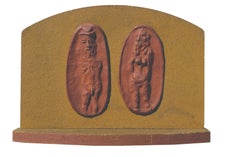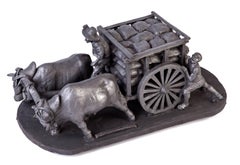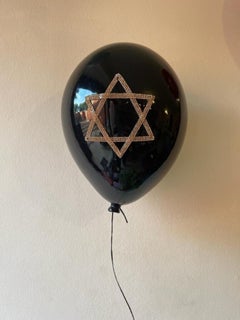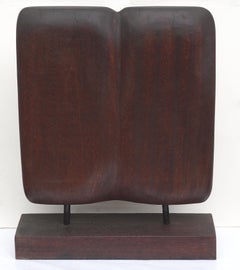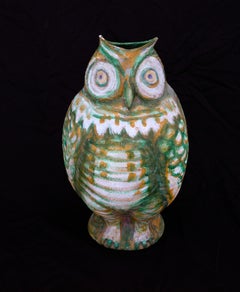Joe Funk Figurative Sculptures
Joe Funk was an American artist and printmaker born in Los Angeles, California, to Polish and German immigrant parents. As a young person in Los Angeles, he showed an interest in art. Funk studied at the Otis and Chouinard Art Institutes and worked on several murals throughout Los Angeles in the Works Progress Administration. He served in the United States Army from 1943–46, in Korea and Okinawa as a heavy anti-aircraft artillery mechanic, instructor and warehouseman. Artist, publicist and graphic designer for special events at Headquarters Company, Asiatic Command. At the ASCOM University in Korea, he was an instructor in pencil sketching. It was during his time in Korea that he developed a lifelong interest in Asian art. Using the G.I. Bill, after the Korean War, he earned a Masters Degree in fine art from the University of Southern California.
In the 1950s, Joe met Lynton Kistler and worked at Kistler’s facility in Los Angeles, the only lithographic press open for business on the West Coast at that time. During his time as an apprentice, Joe printed for many well-known artists, such as Jean Charlot, Man Ray, Max Ernst, Emerson Woelffer and June Wayne. When June Wayne opened the Tamarind Lithography Workshop in Los Angeles in 1960, she offered the status of the fellow printer to Joe Funk. At Tamarind, he began work printing lithographs for guest artists and training future printmakers. After Tamarind, Joe became the technical director at Kanthos Press from 1961–62, where he printed for José Cuevas and Aubrey Schwartz. In 1964, he became co-owner of Joseph Press and was printmaker for Sam Francis, Arnold Belkin and Rico Lebrun. From 1962–64, Joe taught at the Chouinard Art Institute. Joe established a nonprofit corporation in Venice, California in the late 1960s, called Joseph Graphics. Here, he trained apprentice printmakers and printed for numerous artists including Joyce Treiman, Dan Stolpe and Arnold Schifrin. It was in this period of time that Joe began creating sculptures with found objects such as feathers, bones, leather, bits of scrap metal, wire, fabric, paper, wood, plastic, pieces of ceramic, rocks, shells and other small and large pieces of various man-made and organic materials. He called these sculptures Funk Icons. Again, in the late 1970s, he contributed to several mural projects in Los Angeles funded by the Comprehensive Employment and Training Acts grant.
Joe Funk spent the last two years of his life living with cancer. During this time, Dan Stolpe gathered all of his artwork and equipment and brought Joe to live with him in Santa Cruz, California. There, the two of them developed the Native Images printmaking program and facility. A few weeks before his death, Joe gave his life’s work to Native Images, a collection of art that represents his 50 years as an American artist. He died in 1981 in Santa Cruz, California.
(Biography provided by Robert Azensky Fine Art)Mid-20th Century Pop Art Joe Funk Figurative Sculptures
Oil, Clay, Fiberboard
2010s Folk Art Joe Funk Figurative Sculptures
Ceramic, Clay
2010s Contemporary Joe Funk Figurative Sculptures
Ceramic, Clay, Coating, Glaze
2010s Contemporary Joe Funk Figurative Sculptures
Ceramic, Clay, Coating, Glaze
2010s Contemporary Joe Funk Figurative Sculptures
Ceramic, Clay, Glaze
21st Century and Contemporary Pop Art Joe Funk Figurative Sculptures
Resin, Vinyl
Early 2000s Outsider Art Joe Funk Figurative Sculptures
Clay, Slip
2010s Contemporary Joe Funk Figurative Sculptures
Ceramic, Clay, Glaze
2010s Pop Art Joe Funk Figurative Sculptures
Metal
1990s Pop Art Joe Funk Figurative Sculptures
Ceramic, Resin, Mixed Media, Permanent Marker
2010s Contemporary Joe Funk Figurative Sculptures
Ceramic, Clay, Coating, Glaze
21st Century and Contemporary Pop Art Joe Funk Figurative Sculptures
Porcelain
2010s Contemporary Joe Funk Figurative Sculptures
Ceramic, Clay, Oak
Mid-20th Century Pop Art Joe Funk Figurative Sculptures
Metal
Mid-20th Century Pop Art Joe Funk Figurative Sculptures
Ceramic, Oil
